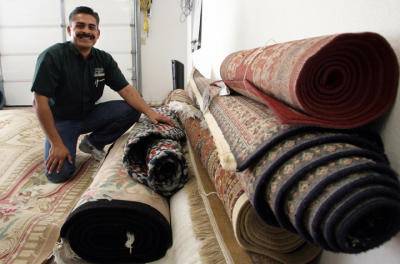
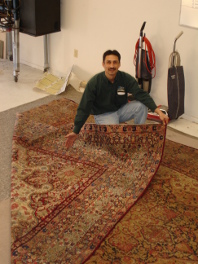
We Specialize In Cleaning All Types of Persian Rugs!
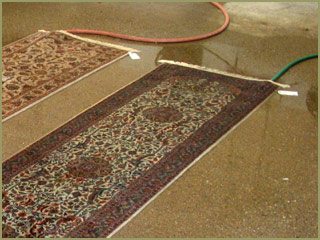
Welcome to our Wash Tour!
LAS CRUCES ONLY AREA RUG – GUARANTEED PET (DOG, CAT) URINE ODOR REMOVAL SERVICE
We will take you on a quick trip through our wash process, from pre-wash inspection to finishing work.
PRE-WASH INSPECTION
Each rug is inspected for any pre-existing conditions. Many times, soil covers up dye lot variations (abrash), fiber staining, prior dye bleeding, worn areas or white knots that become "uncovered" after the wash. Some of these are weaving characteristics (abrash and white knots), and others are damage that can possibly be repaired or reversed.

If you are present when we pick up your rugs, then this inspection takes place with you, and we will discuss any areas of concern that you have regarding your rugs, and your options. If we pick up and transport your rug to our facility while you are out, our wash and repair team
will inspect your rug after its arrival and will contact you with any work recommendations or pre-wash "discoveries."
ABRASH
Abrash is dye-lot color variation. All pre-dyed wool has tone changes that range from off-white to yellow to grey. When this wool is dyed a particular color, this results in a variety of shading. When one "batch" of red wool (for example) is used up in the weaving process, and the weaver grabs the next "batch" from a slightly different color base wool, this difference is woven into the rug. The result is a dye lot variation that runs side to side (left to right) and appears as "striping" in the rug. This is a characteristic in all handmade rugs, and is considered a characteristic that in many cases adds depth and texture to the overall look of the rugs (especially in vegetable dyed wool).
WHITE KNOTS
Most rugs have cotton foundations. Cotton warps run throughout the entire length of a rug, and cotton wefts threads run left to right – and are the means by which each row of wool knots are packed into a straight line and held in place. During the weaving and packing process, cotton warps and wefts will break. A broken warp or weft cannot be replaced, so the two broken pieces are tied in a knot and the weaving proceeds. This results in white "knots" in the field of the rug. Most times these cotton knots are trimmed down shorter than the wool face fibers, and they are effectively "hidden" from view. Over time, wearing of the wool reveals these knots and they look like freckles throughout the rug. These can many times be blended away with textile dye.
ASYMMETRY
Handmade textiles are rarely perfectly symmetrical. Slight design shifts in city rugs, and more noticeable design and shape variations in tribal pieces, are expected. Sometimes these can be counteracted through blocking after the wash (wet cotton foundation fibers can "give" a little – but not too much).
DUSTING
Once the pre-wash inspection is complete and the wash proceeds, the first step is dusting. Some rugs can hold up to one pound of dirt per square foot before it will "look" dirty. Flooding a rug with pounds of fine grit and dirt in the foundation creates mud…so dusting is an important first step to the wash process. This is performed with an upright vacuum cleaner to "shake" the dirt out of the foundation of your rug.
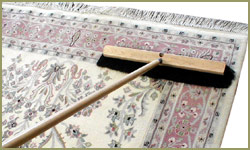 |
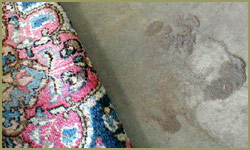 |
FLOODING
The dyes of your rug are tested for colorfastness. If the dyes are not colorfast, then the rug is bathed first in vinegar to set the dyes during the wash process. The rug is then given a cold water, mild shampoo bath, using soft brushes for mild agitation. The rug is soaked for a certain length of time, depending on how much surface soil and spotting needs to be gently worked out and rinsed from the rug's fibers. The rug is thoroughly rinsed with water, and then placed through a rubber roller wringer to gently squeeze the water from the rug (the rollers adjust to the thickness of each rug).
DRYING
All of our rugs are laid out flat to dry. Hanging textiles up when wet can lead to too much strain on the foundation of the rugs. Air movers are used to help facilitate drying, without the use of high heat (so there is no worry of shrinkage). Upon a first wash, it is typical for a rug to shrink slightly (less than an inch) – just as cotton and wool clothing does in even a cold water hand wash. And as with throwing wool or cotton in a high heat dryer, you know this shrinks natural fibers…this is why we dry our rugs the way we do.
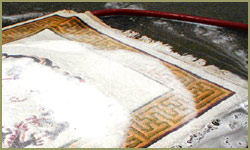 |
 |
FRINGE WORK AND FINISHING
Fringe tassels are washed an additional time after the bath. The tassels are then dried. The rug is given a final grooming with a horsehair brush, and then rolled and ready to go home.
